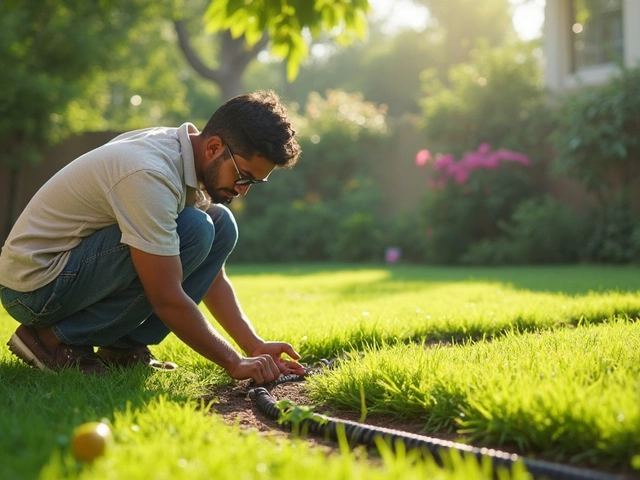Irrigation Line Burial: Simple Steps for a Neat Garden
Ever looked at a tangle of drip tubing and thought, "There’s gotta be a cleaner way?" Burying your irrigation line does just that. It hides the hose, protects it from sunlight, and cuts down on weeds. Below is a practical, no‑fluff guide to get your lines underground in a few hours.
Plan Your Layout Before You Dig
First, draw a quick sketch of your garden beds. Mark where each plant sits and the distance between rows. Use that map to decide the path of the main line and any laterals. Keep the main line about 12‑18 inches deep – deep enough to stay cool, shallow enough to reach plants without a shovel every time you need a repair.
Pick a sturdy, UV‑protected drip tubing or a polyethylene pipe. If you’re in a hot region, a black‑coated pipe helps retain moisture and prevents algae growth. Make sure the fittings are rated for underground use – they’ll be harder to replace if they aren’t.
Digging and Laying the Line
Grab a trenching shovel or a mini‑tractor if you have a big yard. Dig a trench following your sketch, keeping the bottom smooth and free of sharp rocks. Rough spots can nick the tubing and cause leaks later.
Lay the pipe in the trench and feed it gently. If you need bends, use flexible elbows instead of forcing the tube around corners – it reduces stress points. When you reach the end of a run, attach a pressure regulator and filter. A good filter stops sediment from clogging the emitters, especially important when the line is buried.Before you backfill, test the system. Turn on the water and walk the line, checking for leaks at each joint. A quick patch with garden‑grade sealant saves you from re‑digging later.
Backfilling the Trench
Start by covering the line with a thin layer of sand or fine soil. This cushion protects the pipe from rocks that might shift over time. Then, add the excavated soil in increments, tamping each layer down gently. Avoid compacting the soil too hard – you want some drainage around the pipe.
If you live in an area with frost, consider a top layer of mulch. Mulch insulates the line and also suppresses weeds, giving you double benefits.
Maintenance Tips for Buried Lines
Even buried lines need a little love. Once a season, flush the system with clean water to clear any buildup. Keep the filter clean and replace it as per the manufacturer’s guide.
Watch for soggy spots in the garden. They can signal a hidden leak. If you spot one, dig a small section to locate the problem and repair it with a spare connector.
That’s it – you’ve turned a messy hose into a sleek underground system. The effort pays off in tidy beds, less water loss, and fewer weeds. Grab your shovel, follow these steps, and enjoy a garden that looks as good as it works.
How Deep Should Drip Irrigation Lines Be Buried? Guide for Optimal Water Delivery
Learn the right burial depth for drip irrigation lines, factors that affect it, and step‑by‑step installation tips for healthy gardens.
About
Drip Irrigation
Latest Posts


Understanding the Drawbacks of Drip Irrigation Systems
By Alden Thorne Dec 24, 2024

Pebble Tray Care: How Often Do You Need to Fill It?
By Alden Thorne May 20, 2025

Furnishing Your Terrace: Tips and Tricks for a Green Escape
By Alden Thorne Mar 2, 2025

